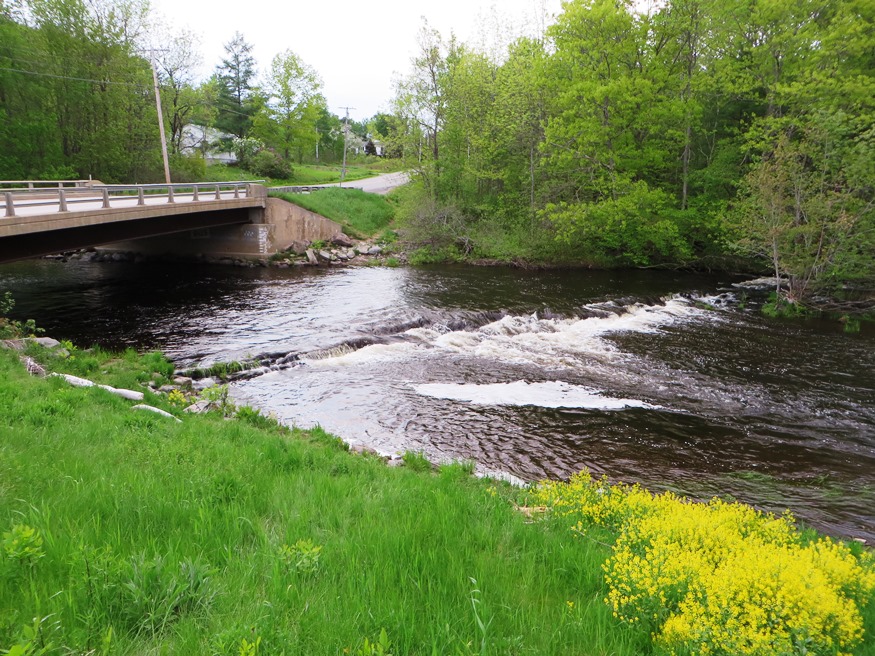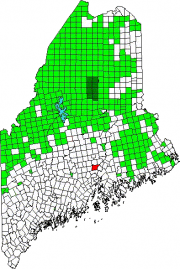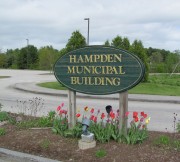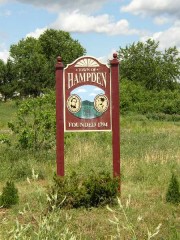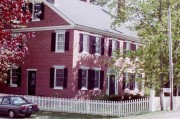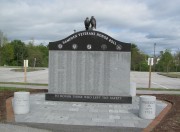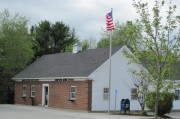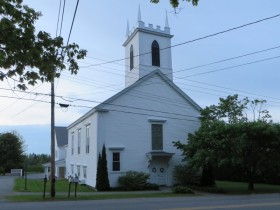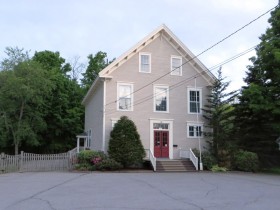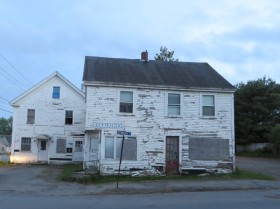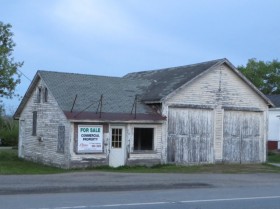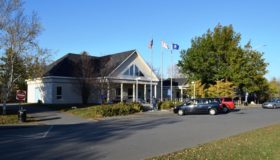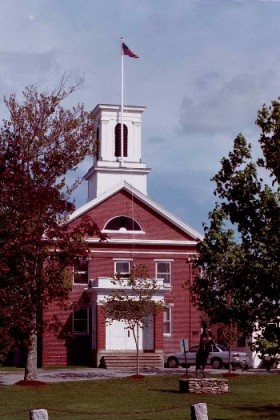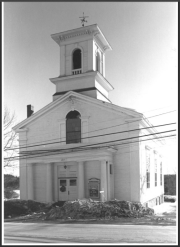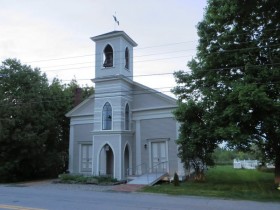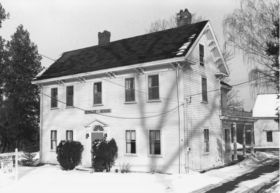| Year | Population |
|---|---|
| 1970 | 4,693 |
| 1980 | 5,250 |
| 1990 | 5,974 |
| 2000 | 6,327 |
| 2010 | 7,257 |
| Geographic Data | |
|---|---|
| N. Latitude | 44:43:32 |
| W. Longitude | 68:53:26 |
| Maine House | District 101 |
| Maine Senate | District 10 |
| Congress | District 2 |
| Area sq. mi. | (total) 39.0 |
| Area sq. mi. | (land) 38.1 |
| Population/sq.mi. | (land) 190.5 |
County: Penobscot
Total=land+water; Land=land only |
|
[HAM-den] is a town in Penobscot County, incorporated on February 24, 1794 from Sowerdaescook Plantation. From 1816 through 1832 it annexed land from Frankfort, Newburg, and Hermon.
The town is a suburb of Bangor lying just south of that city on U.S. Route 1A. It hosts a regional U.S. Post Office processing center.
Settled in 1767 it was once known as Wheelersborough after the first settler, carpenter, and mill owner. The Historical Society now occupies the Benjamin Wheeler “Moodywood” house, at left, built in 1802.
The town was eventually named for John Hampden a 17th century English patriot who protested the excesses of Charles I.
In 1796 the township was surveyed by Ephraim Ballard, and each household received 100 acres. Original settlers paid $6; those arriving after 1794 paid $50.
During the War of 1812, the British occupied Hampden, after routing the local militia, in an attempt to capture a disabled U.S. vessel Adams. The vessel was blown up by the militia, commanded by Holden’s John Blake, to keep it from British hands.
Hampden was the birthplace, in 1838, of U.S. Representative Thompson Henry Murch, who served in Congress in the late 19th century.
It is also the longtime home of 19th century U.S. Representative Charles Stetson.
In the 1840’s, Hannibal Hamlin, Vice President under Abraham Lincoln, practiced law here before moving to Bangor in 1851.
It is the birthplace of social reformer Dorothea Dix, whose father Joseph was a land agent for his own father Dr. Elijah Dix, after whom Dixmont and Dixfield are named. A park in Ms. Dix’s name is located on the farm site where she was born.
Hampden Academy was established in 1803 and the Grange Hall, one of the first chartered Granges in Maine (1880), has its home in the town. While teaching here Stephen King was spending his weekends and evenings writing short stories and novels.
While most of the population is in Hampden village and Hampden Highlands near the Penobscot River, the Kennebec Road leads west into the rural areas. Nealeys Corner (Delorme map spelling) is a small spot at the intersection of Kennebec Road and Route 69 in the southwestern corner of the town.
Souadabscook Stream is often the site of canoe races. It also once was the location of a mill, possibly Emerson Mill, whose ruins are visible near the bridge over the stream on Papermill Road.
Hampden Highlands is a neighborhood near the main village.
As in many communities, old buildings with memories of times past have outlived their useful lives. Photos at least provide a record of their existence.
Hampden is the site of one of several Visitor Centers along Interstate 95 at N44° 46′ 1.91″ W68° 53′ 13.76″. Each has restrooms, vending machines, and an area with informational brochures on lodging, cultural and recreational attractions.
Congressional Medal of Honor recipient:
Indian Wars WILBUR N. TAYLOR
Form of Government: Council-Mayor-Manager.
Additional resources
Chadbourne, Ava Harriet. Maine Place Names and The Peopling of its Towns.
Echoes from the Past: Hampden, Maine. Hampden, Me.? Hampden Historical Society? 2000. Bangor, Me. Northeast Reprographics.
Echoes from the Past , Volume II: Hampden, Maine. Bangor, Me. Northeast Reprographics. 2001.
Emerson, Paul. Hampden, Me. Soldiers and Sailors of the Civil War. Frankfort, Me.? P. Emerson. 1998?
Hampden Historical Society. Historical Sketches of the Town of Hampden, Maine. Ellsworth, Me. The Ellsworth American. 1976.
Maine. Newcomb, Richard M. History of Riverside Park, Hampden, Maine, 1898-1916. Bangor, Me. Bangor Printing Company. 2001.
Varney, George J. A Gazetteer of the State of Maine. 1886. p. 265-267.
National Register of Historic Places – Listings
Hampden Academy
[Alt. US Route 1] As Maine’s interior became settled after the American Revolution, newly established communities founded academies for the education of their children. Hampden received authorization for its academy from the Massachusetts Legislature in 1803. The legislature granted the school’s board of trustees 11,040 acres of northern Maine land in what is now Weston, Aroostook County. The land was sold by the board, funds for the construction of a two story frame building in 1806. By the following year, the school was completed; and the preceptor, Phineas Johnson, was hired. The first term in 1807 was attended by between forty-five and fifty students.
The schoolhouse was destroyed by fire on February 24, 1842. The board acted quickly to replace it with the current brick building. The Academy’s Greek Revival design is similar to at least two other academies in the region, Bloomfield of 1840 in Skowhegan and Athens of 1846.
Forty years after receiving its charter, the Academy opened its brick building in 1843. In 1850 the Maine Legislature granted the school two hundred dollars with which to buy chemicals and laboratory equipment. A misguided chemistry experiment caused a fire in 1854. The damage was limited to the first floor and was quickly repaired.
Three times during the mid-nineteenth century, the Academy tried to expand its curriculum to the college level. In 1856, it graduated four women who had taken a course of study almost identical to Bowdoin College’s in Brunswick, then restricted to men. Between 1860 and 1862, the school offered a normal school course to prepare students for grammar and secondary level teaching. The next year the Legislature created two state normal schools. An attempt was made to locate one at Hampden in connection with the Academy, but Castine and Farmington secured the schools. After these experiences, the trustees turned their efforts to grammar and secondary education.
Hampden Congregational Church
[Main Road] Built in 1835, the Hampden Congregational Church is a handsome rectangular frame building which blends Federal and Greek Revival style features with an Italianate bell tower. The robust character of its Greek Revival details and the unusual front porch distinguish the church from the majority of its contemporaries. The Church traces its origin to an organizational meeting held on May 6, 1817, by Rev. Jehudi Ashmun of the Maine Charity School. This meeting was apparently held at the School’s temporary quarters in the Hampden Academy.
In November of 1834 a lot was given to the Church and the building was completed in 1835. In 1888 a sketch of the church building was prominently illustrated in the record of the Sixty-third Annual Meeting of the Penobscot County Conference of Congregational Churches.
The building continued to serve the congregation at least through 1987. Church records refer to repairs made to the pulpit, gallery and vestry windows in 1846 and money subscribed for expenses of the belfry in 1863. Presumably it was about this time that the tower was added to the building. Of particular note is the remarkable similarity which exists between this tower and the belfry of the Washington County Courthouse in Machias. The latter, built in 1854, was designed by Bangor architect Benjamin S. Deane. Whether he was responsible for the design of this addition has not yet been determined.* [Kirk Mohney photo]
Harmony Hall
[24 Kennebec Road] The Hall is a facility that has served as a public venue for civic groups associated with public advancement, education, and entertainment since 1896. The eclectic building, with Federal, Greek Revival, Gothic Revival and Queen Anne architectural styles, was originally built as the Universalist Chapel in 1829.
It was substantially renovated for use as a social meeting hall by the Village Improvement Society in 1896. The Society was the first of several, female-centered organizations associated with the Hall that focused on a progressive agenda during the late 19th and early 20th century. It was designated a local landmark by the Hampden Historic Preservation Commission in 1993 for its association with womens’ organizations: the Village Improvement Society, the Dorothea Dix Memorial Association, the Hampden Garden Club, and local Suffragists.
The building now known as Harmony Hall was built in 1828 and sold to the Proprietors of the Universalist Chapel in July 1829. The church was the second house of worship in the town whose Methodist, Congregationalist, Universalists and Baptists had been meeting in the Union Church since 1794. Less than a decade later each of the other denominations had built houses of worship: the Methodist Church on Kennebec Road in 1833 (see photo above); the First Baptist Church in 1834; and the Congregational Church in 1835. Each of these buildings followed a common pattern: gable front facades, three bay long side elevations and low belfries straddling the ridge just behind the facade. By 1885 services of the Universalist Society ceased and the building was closed. Ten years later the Village Improvement Society obtained the Chapel and undertook extensive alterations to the Hall.
Kinsley, Martin, House
[Main Road, Hampden Highlands] The Kinsley House is not only one of Hampden’s earliest surviving residences, but a monument to Martin Kinsley, the first representative to the U. S. Congress from the (then) District of Maine. His house is also linked to a notable piece of folklore involving the War of 1812. Martin Kinsley (1754-1835) came to Hampden from Hardwick, Massachusetts in 1797. He was a Harvard graduate, studied law, and served as a major in the Massachusetts militia, 1780-86. Sympathy with Shay’s Rebellion cost Kinsley his commission, but the rebel party rewarded him with town and state offices. He served in the Massachusetts Assembly that adopted the Commonwealth Constitution. Kinsley’s credentials—particularly his education and political experience—were virtually unique among Penobscot Valley settlers of the 1790s-1800s. He successively occupied the area’s major political offices. He served as Justice of the Peace from 1802, Representative from Hampden to the General Court (1801-06, except 1805), Member of the Executive Council (1810-11), State Senator from Hancock County (1814), and in 1819-21 served as the first Representative from the District of Maine to the U. S. Congress. He also held a number of judicial posts, including Justice of the Court of Sessions, Judge of the Court of Common Pleas for the Eastern Circuit, and Judge of Probate.
Kinsley’s house was built about 1797. It is fairly simple for a man of Kinsley’s station, displaying only minimal ornament and having only four rooms in the main portion. Legend has it that during the Battle of Hampden (1814) between British regulars and local militia, the British attempted to use Kinsley’s house as a headquarters. Mrs. Kinsley barricaded the doors, however, and emptied the contents of a chamberpot upon British officers standing before the entrance. Her defense was reportedly successful. Kinsley himself was briefly held hostage on a British warship during the same battle. [Frank A. Beard photo]


